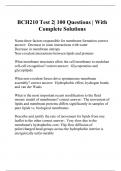Exam (elaborations)
BCH210 Test 2| 100 Questions | With Complete Solutions
- Course
- BCH210
- Institution
- University Of Toronto (U Of T )
Name three factors responsible for membrane formation correct answer: Decrease in ionic interactions with water Decrease in membrane entropy Non-covalent interactions between lipids and proteins What membrane structures allow the cell membrane to modulate cell-cell recognition? correct answer...
[Show more]



